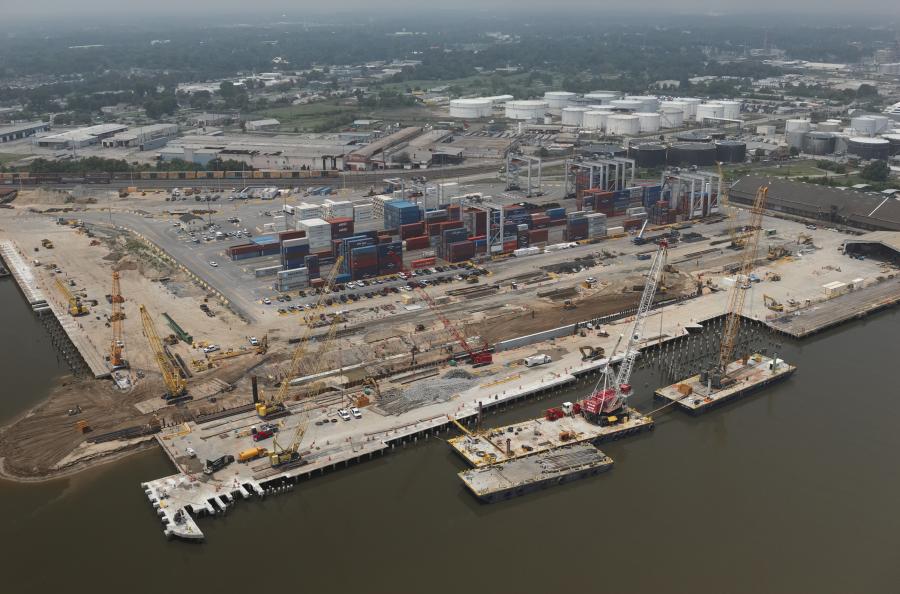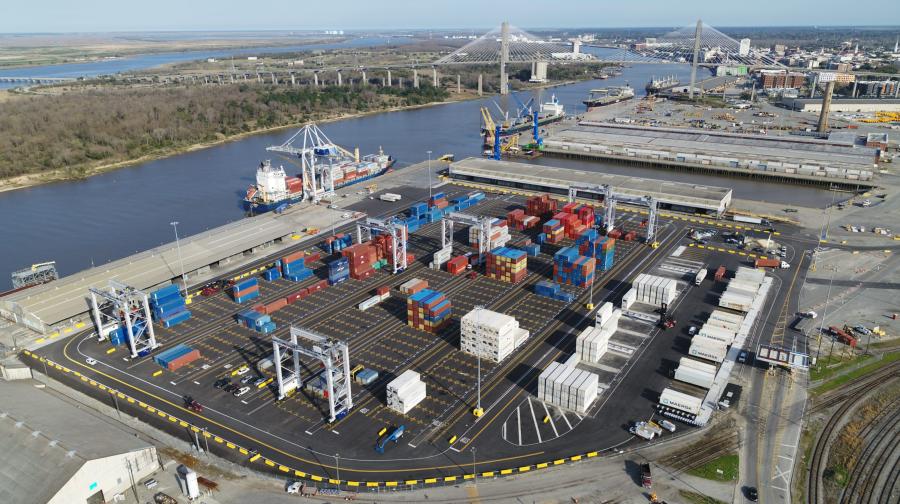Repurposing the current Ocean to service ships transporting containers is more efficient compared to constructing a new facility.
(Georgia Port Authority photo)
The Georgia Ports Authority (GPA) is spending $410 million to transform and upgrade the 200-acre Ocean Terminal in the Port of Savannah, a project that is being undertaken by The Industrial Company (TIC), which is responsible for the wharf/berth refurbishment element.
The new Ocean Terminal berths are being constructed in phases, with the first expected to open in 2025 and the second one year later. The entire project is expected to take five years to complete.
The current Ocean Terminal, a dedicated breakbulk and roll-on/roll-off facility, provides customers with more than 1.4 million sq. ft. of covered storage and has five berths with direct rail access. It handles the majority of the state's breakbulk cargo, that includes steel, paper and lumber. These operations are currently being transferred to the Port of Brunswick, roughly 70 mi. south of the Port of Savannah. Savannah is the country's fourth-busiest container port and is experiencing a $10 million upgrade to accommodate more cargo and provide more efficient services.

"The Authority is transitioning the 200-acre Ocean Terminal in Savannah," said Edward Fulford, the GPA's manager of media relations. "Having handled a mix of containers and breakbulk cargo for 40 years, Ocean Terminal will become an all-container facility. Demolition has begun to make way for berth improvements and container yard construction. Rebuilding the docks will provide 2,800 feet of berth space, capable of serving two big ships simultaneously.
"Another eight cranes are destined for Ocean Terminal," he added. "Expanded gates and paving will allow for two million TEUs of annual container yard capacity. By 2026, these renovations will provide space for expanding trade and vessel operations. We're also improving the paving surface to hold container stacks. These projects will bring to six the number of neopanamax vessels the Port of Savannah can handle simultaneously. To work the larger ships, GPA will add eight new all electric ship-to-shore cranes at Ocean Terminal by 2026. The taller ship-to-shore cranes will replace three older cranes that are not suited to handling neopanamax vessels."
The eight cranes will cost $163 million.
Konecranes OYI, a Finnish company, is providing the ship-to-shore cranes.
Last March, the GPA announced that it agreed to spend $170 million on 55 hybrid-engine rubber-tired gantry cranes to outfit the Ocean Terminal, as it is redeveloped into an all-container facility.
"This significant investment in new equipment will help prepare the Port of Savannah to handle more ships and cargo while maintaining the world-class service our customers have come to expect," said GPA Executive Director Griff Lynch. "These new machines will expand our capabilities, operate at lower cost and leave a smaller carbon footprint than conventional diesel cranes."
Lynch noted that repurposing the current Ocean to service ships transporting containers is more efficient compared to constructing a new facility.
The cranes will exclusively operate off electric battery power, with diesel generators running only to recharge batteries. This will reduce fuel consumption by an estimated 47 percent compared to all-diesel machines. Per-year, that is a reduction of 8,800 gal. of diesel per crane, or nearly 500,000 gal. annually across the Ocean Terminal fleet.
"This will result in a fuel purchase savings of more than $1.6 million per-year at current rates," said Fulford.
The new cranes reduce emissions by 50 percent compared to conventional diesel cranes. At an annual average of 4,000 operating hours per RTG, the hybrid engines will avoid yearly emissions of 127 tons per crane, or nearly 7,000 tons across the 55-RTG fleet.
"With every infrastructure expansion, the Georgia Ports Authority seeks to ensure its operations progress toward improved long-term sustainability," said GPA Board Chairman Joel Wooten. "Economic development, environmental stewardship, governance, and employee and community engagement are all important facets in that effort."
The gantry cranes will use special "whisper" movement alarms that sound like static, rather than the typical three-tone alarms. The combination of hybrid power and quieter alarms will help control the sound of operations for neighboring communities.
"The new cranes can work stacks that are six containers high and seven wide – one container wider than GPA's current largest RTGs," said Fulford. "Wider stacks mean fewer rows and a denser, more efficient use of space. The RTGs currently serving Ocean Terminal will be repurposed in other areas of operation."
A key partner for the GPA is the Georgia Department of Transportation (GDOT), which will play an important role in the terminal's completion and traffic control around Ocean Terminal.
"GDOT is currently reviewing plans to route port traffic directly from the terminal onto U.S. 17/Interstate 16, avoiding near-port streets, which could minimize community impacts," said GDOT's Susan Gardner, senior director of operations and projects. "Directing trucks in this manner will expedite cargo, while preventing unnecessary traffic in neighboring communities." CEG
Irwin Rapoport
A journalist who started his career at a weekly community newspaper, Irwin Rapoport has written about construction and architecture for more than 15 years, as well as a variety of other subjects, such as recycling, environmental issues, business supply chains, property development, pulp and paper, agriculture, solar power and energy, and education. Getting the story right and illustrating the hard work and professionalism that goes into completing road, bridge, and building projects is important to him. A key element of his construction articles is to provide readers with an opportunity to see how general contractors and departments of transportation complete their projects and address challenges so that lessons learned can be shared with a wider audience.
Rapoport has a BA in History and a Minor in Political Science from Concordia University. His hobbies include hiking, birding, cycling, reading, going to concerts and plays, hanging out with friends and family, and architecture. He is keen to one day write an MA thesis on military and economic planning by the Great Powers prior to the start of the First World War.
Read more from Irwin Rapoport here.
Today's top stories

















